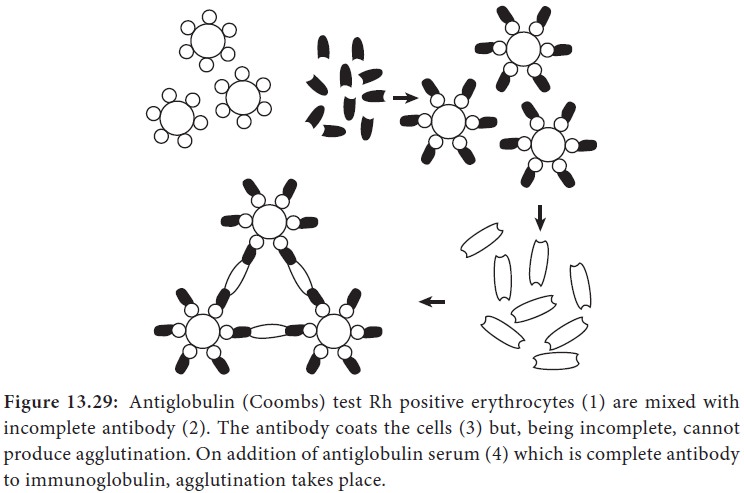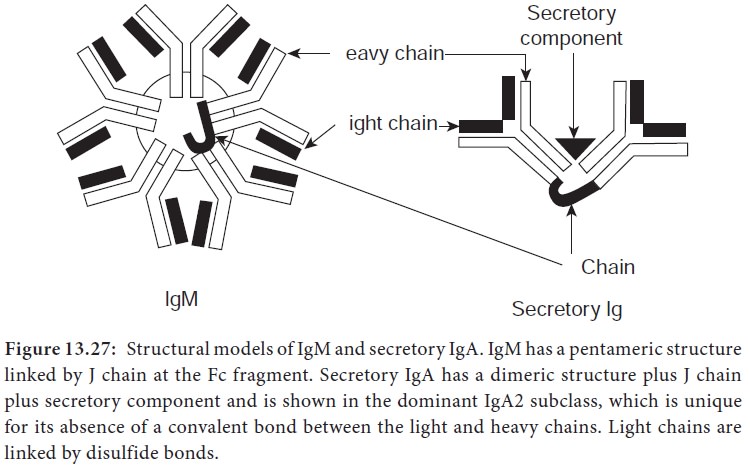Chapter: 11th Microbiology : Chapter 13 : Immunology
Properties and Activities of Immunoglobulin Classes
Properties and Activities of
Immunoglobulin Classes
Each immunoglobulin class
differs in its general
properties, distribution in the
body and interaction
with other components of the host
defensive systems.
i) IgG
·
IgG is the major immunoglobulin in human serum, accounting for
80% of the immunoglobulin pool.
·
It is present in blood plasma and tissue fluids. It has a
monomeric structure.
·
IgG class acts against bacteria and viruses by opsonizing the
invaders and neutralizing toxins and viruses.
·
IgG molecules are capable of fixing complement, except for IgG4.
·
It is the major antibody in the secondary immune response and it
has half life of 23 days.
·
IgG is the only immunoglobulin molecule able to cross the placenta
and provides natural immunity in utero and to the neonate at birth.
ii) IgA
It is present in the serum and in various bodily secretions and
thus takes two forms – serum IgA and secretory IgA (sIgA)
A) Serum IgA
·
It accounts for about 12% of serum immunoglobulin.
·
In humans, over 80% of serum IgA exists in a monomeric form and
the remaining existing as polymers in the form of dimers, trimers or tetramers.
In polymeric IgA, the monomeric units are linked by disulphide bonds and
joining (J) chain.
·
Serum IgA fixes complement via the alternative pathway. It has a
half life of 5 days.
B) Secretory IgA
1.
SecretoryIgA is the primary immunoglobulin of mucosal associated
lymphoid tissue (MALT). It is also found in saliva, tears, and breast milk.
2.
It consists of two monomeric units plus J chain and secretory
component (Figure 13.29).

3.
The dominant subclass of sIgA is sIgA2 which is unique for its
absence of a covalent bond between the light and heavy chains. In this
subclass, light chains are linked by disulphide bonds.
4.
It has a half life of 5-6 days. It is responsible for local
immunity.
5.
The sIgA molecules protect mucosal surfaces by reacting with the
surface of potential pathogens and interfering with their adherence and
colonization. It also plays a role in the alternative complement pathway.
iii) IgM
·
IgM accounts for about 5-10% of the serum immunoglobulin pool.
·
It has a pentameric structure consisting of five monomeric units
linked by J chain and disulphide bonds at the Fc fragment (Figure 13.27).

·
It is the predominant antibody in the primary immune response to
most antigens and the predominant antibody produced by the fetus.
· It is the first immunoglobulin made during B cell maturation and individual IgM monomers are expressed on B cells, serving as the antibody component of the B cell receptor (BCR).
·
IgM tends to remain in the bloodstream, where it agglutinates
(clumps) bacteria, activates complement by the classical pathway and enhances
the ingestion of pathogens by phagocytic cells.
·
It has a half life of approximately 5 days.
iv) IgD
·
IgD accounts for about less than 1% of the total immunoglobulin
pool.
·
One unique structural feature is the presence of only a single
H-H inter chain bond along with two H-L interchain bonds.
·
It has a monomeric structure similar to that of IgG.
·
IgD antibodies are abundant in combination with IgM on the
surface of B cells and thus are part of the B cell receptor complex. Therefore
their function is to signal the B cell to start antibody production upon initial
antigen binding.
·
It has a half life of 2-3 days.
v) IgE
·
IgE accounts for only 0.004% of serum immunoglobulin. It has a
monomeric structure. It is also called reagin or reaginic antibody.
·
Theskin sensitizing and anaphylactic antibodies belong to this
class.
· The Fc portion of IgE can bind to Fc receptors specific for IgE that are found on mast cells, eosinophils and basophils. Thus these cells can become coated with IgE molecules. Whentwocell-boundIgEmolecules are cross linked by binding to the same antigen, the cells degranulate. This degranulation releases histamine and other mediators of inflammation.
·
IgE also stimulates production of an excessive number of
eosinophils in the blood (eosinophilia) and increased rate of movement of the
intestinal contents (gut hypermotility) which aid in the elimination of
helminthic parasites. IgE has a half life of 2-3 days.
Related Topics